RIGHT TURN ONLY!!
Konnichiwa, Zetsubou-sensei
by Carlo Santos,

It's baseball season!
Baseball season!
And the World Baseball Classic is on again this year! (But of all international sporting events, why does it run on a 3-year interval? That's just weird...)
HAYATE X BLADE
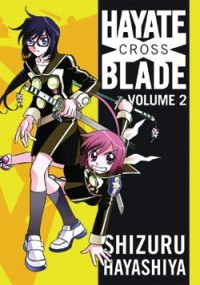
Vol. 2
(by Shizuru Hayashiya, Seven Seas, $9.99)
FROM THE BACK COVER:
"When Hayate first arrived at Tenchi Academy, she was just a temporary fill-in for her injured twin sister, Nagi. Now a student in her own right, Hayate and her new sister-in-arms, Ayana, are ready to show their dueling prowess and take the Hoshitori by storm! Things aren't going so well for Hayate's roommate, Momoka, who may be thrown out of Tenchi Academy if she doesn't defeat her best friend's abusive partner in an officially sanctioned duel.
Meanwhile, Hayate and Ayana have troubles of their own as they race to save the orphanage where Hayate grew up from a mountain of debt before the yakuza comes to collect. Not only that, as Sports Day approaches, Hayate must learn a vital lesson—that when push comes to shove, a new friend can turn out to be your worst enemy..."
EVIDENCE FOR:
If there is one constant in Hayate X Blade, it's that Hayate's relentless energy can propel the series even when the storyline starts to flag. See, not every page can be a dazzling swordfight scene, and that's when Hayate's pure idiocy steps in to provide ongoing amusement—along with Ayana's scathing comebacks. Yuri overtones, what yuri overtones? The real appeal of the characters is that they form such great comedy duos! Even the supporting cast gets in on the fun, as proven by characters like Isuzu the creepy ghost girl and pint-sized Sou, whose energy level is rivaled only by Hayate's. Meanwhile, swordfights of varying styles fill up the action quota in this volume, from the serious-minded high-stakes duel between Momoka and Ouka (culminating in the hilarious "Straight-Up Brainless Blade") to the highly unconventional style that Ayana has to improvise when Hayate inexplicably falls asleep in the middle of battle. Yeah, if you wanted real swordfighting you could read some grim seinen samurai stuff. This is for people who want to be entertained.
EVIDENCE AGAINST:
Actually, it's hard to imagine this series being entertaining at all. Not when most of it involves dumb jokes about Hayate's intelligence level, whiny high school relationship drama (except only involving girls), or people explaining the roundabout rules of the Hoshitori tournament system. Oh, was there supposed to be some swordfighting amongst all that? It's hard to say when the battles comprise maybe 20% of the storyline ... on a good day. Even worse, the action often becomes hard to read because of the cluttered art, where characters and dialogue all seem to be squeezing against each other for room on the page, and crucial moments in a fight scene become a guessing game of What's Going On In This Panel. So what we have here is a comedy that isn't very comedic, relying mostly on predictable punchlines about the main character's stupidity; an action series that contains barely any action or a poor rendition of it; and some supposed relationship issues despite the actual character pairings having all the romantic content of a tax document. Trying to straddle so many genres at once is probably the reason why the series is failing at all of them.
FINAL VERDICT:
Hayate's sheer energy is pretty much the only thing that's done well, and once you get tired of that, there is very little else to lift this series anywhere above a D.
JIHAI
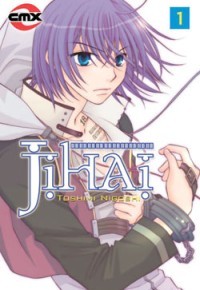
Vol. 1
(by Toshimi Nigoshi, CMX, $9.99)
FROM THE BACK COVER:
"When his childhood friend is murdered, 17-year-old clone Aoi spends his last year to live looking for the killer! As he searches for revenge, Aoi uses his ability to travel through the Jihai (wasteland), where supposedly nothing can survive, to act as a courier. After a routine delivery goes wrong, a pistol-packing padre named Tristram saves Aoi, but Tristram's buddy Dis accidentally runs him over!
Tristram and Dis take Aoi back to their home country—a place where clones are treated like people, not possessions—to heal his ankle. But Aoi quickly realizes something is amiss in this new land. What are Tristram and Dis hiding, and will they be allies in Aoi's cause... or a threat?"
EVIDENCE FOR:
With its futuristic flourishes and constant sense of urgency, Jihai is one series that truly earns the genre label of "action." Heck, the lead character even changes from being pursued to being a pursuer—that's how much urgency there is. Making things even more compelling is the moment when a supporting character has his true identity exposed; story elements like that require careful timing, and this one does a great job of keeping the reader in suspense until everything breaks wide open. Of course, keeping up that pace would not be possible without well-planned layouts, and the rectangular paneling here is the kind that gets straight to the point. It's surprising, actually, because you'd think that a series with dashing pretty boys around every corner (another positive, I suppose) would be nothing but sparkles and frills and unreadable screentone-tastic layouts, but instead, forward-charging action and clear-cut cityscapes provide the true artistic impetus. The thrill of the chase, and the resulting confrontations, make this one a winner.
EVIDENCE AGAINST:
Wow, Toshimi Nigoshi, you haven't improved at all since the failure that was Flat Earth Exchange, have you? Attractive characters and a sense of urgency are good, but not if they're wasted on poor storytelling technique. What use is a clever plot twist if awkward scene transitions and staging make it a pain to figure out? What use is good visual layout if the positioning of dialogue bubbles makes it impossible to tell which characters are speaking? What use are bishounen if no one can remember the names and faces in the story? (Seriously, it's almost like crying out, "Please! Make yaoi doujin of my characters!") Having a well-established big picture means nothing if you can't work out the little details. Even peripheral material, like the social and political climate and beautifully designed city backgrounds, go to waste because the characters are too busy having vaguely homoerotic conversations with each other while standing in blank spaces. It's sad, because the sci-fi side of this is pretty interesting, but no, it's just another cheesy action-thriller where cool dudes stand around trying to act tough while making no sense.
FINAL VERDICT:
Could've been the start of a great action/sci-fi title. Instead, it turns out to be a ridiculous bishounen-fest of confusing story revelations and lots of wasted potential for a C-.
NARUTO
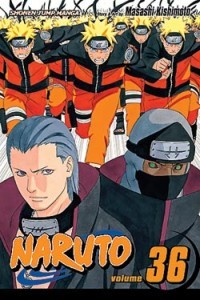
Vol. 36
(by Masashi Kishimoto, Viz Media, $7.95)
FROM THE BACK COVER:
"Naruto is a ninja-in-training with an incorrigible knack for mischief. He's got a wild sense of humor, but Naruto is completely serious about his mission to be the world's greatest ninja!
Asuma's new team and the former Cell Number 10 battle Hidan of the Akatsuki, who may be the most unstoppable foe the Konoha ninja have encountered—and who could mean the end for one of Naruto's longest-standing allies. As Naruto prepares for the worst, the Akatsuki reveals its master plan!"
EVIDENCE FOR:
After getting this deep into the series, it's hard not to enter spoiler territory, but let's just say this: it takes some real talent to take a highly conventional death scene and still make it a genuinely emotional. It's got all the elements of cheese: the hero's dying gasps, the final speech to his comrades, a flood of youthful memories—and yet Masashi Kishimoto still manages to pull at your heartstrings with all of it. Heck, it's not even as if it's a major character, but the way Naruto is built, every character matters. That's how great a series this is. But enough with the weepy eulogizing—this volume also packs a heated battle, with Shikamaru getting a chance to shine as Konoha's greatest tactician, plus a villain who can't be killed, and the dynamic artwork we've come to expect from Kishimoto's action scenes. Some of the most visually inventive scenes, however, go to Naruto himself, who's still studying how to make a jutsu from scratch and providing us with one of the most gripping training arcs yet. Just observe what Kakashi has to say about his student and see if you're not impressed.
EVIDENCE AGAINST:
Do I just have the bad luck of reviewing a volume of Naruto every time Naruto drops off the map? Once again the titular hero gets pushed to the side, because they've sent the third-stringers to deal with the Akatsuki, and frankly, the battle—epic as it is—just isn't as cool as watching Naruto learn jutsu theory. After all, there have been plenty of great fights throughout the series, but how often do we get to see the inner workings of ninja technique? Not often enough, which is a shame. And because of that storyline switch, the first few chapters are a multi-threaded mess, jumping between Naruto and the Akatsuki and the people chasing the Akatsuki like a plotwise pinball machine. But if that seems like a pain to deal with, just wait until the last chapter, where the Great Akatsuki Master Plan is finally revealed ... and turns out to be exactly like every plan drummed up by every other villain EVER. What a letdown. Oh, and Kishimoto still doesn't use enough screentone. Just saying.
FINAL VERDICT:
This one's got a blistering battle and a beautiful death scene, only to be ruined by a messy first couple of chapters and an overly predictable last one. And where did Naruto disappear off to? Oh well, it's still worth a B.
PLUTO
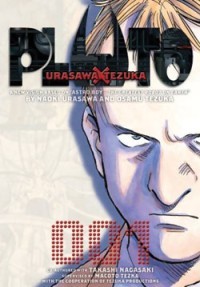
Vol. 1
(by Naoki Urasawa and Osamu Tezuka, Viz Media, $12.99)
FROM THE BACK COVER:
"In an ideal world where man and robots coexist, someone or something has destroyed the powerful Swiss robot Mont Blanc. Elsewhere a key figure in a robot rights group is murdered. The two incidents appear to be unrelated ... except for one very conspicuous clue—the bodies of both victims have been fashioned into some sort of bizarre collage complete with makeshift horns placed by the victims' heads. Interpol assigns robot detective Gesicht to this most strange and complex case—and he eventually discovers that he too, as one of the seven great robots of the world, is one of the targets."
EVIDENCE FOR:
If you're a Monster fan looking for the appropriate "by the creator of..." follow-up, this is it. Pluto wastes no time getting off to a gripping start—the dramatic "murder" of a robot will do that—and only gets more intense as Urasawa meticulously adds new layers of plot with each chapter. And yet, it's a tangential story arc that really carries this first volume: the tale of retired war robot North No. 2 is storytelling at its finest, a brilliant exercise in character development that builds up to some powerful displays of emotion. Yes, Urasawa still loves coming in from odd angles with a seemingly unrelated story and only revealing the connection to the main plotline at the end, but he can do that because he's just so good at it. His talents don't stop there, either—confident and expressive artwork are also essential in bringing this story to life, from the striking futuristic backgrounds to the wide range of character designs. The most memorable artistic touch, though, may be seeing the re-imagined versions of Tezuka's robots (just wait until the last page). Now that is truly where the masters meet.
EVIDENCE AGAINST:
Maybe even the great "master of suspense" has to lean on creaky formulaic devices from time to time. The chapter where Gesicht pays a visit to notorious robot criminal Brau 1589 is the most glaring one, adding little to the story apart from the familiar scenario where a detective tries to wrangle one essential clue out of some deranged old psycho killer. Even the North No. 2 arc has its shortcomings, relying on the rather predictable "Here's what really happened during your tortured childhood!" turnaround to trigger a change of heart. And despite his reputation as a great storyteller, Urasawa's technique of coming in from a tangential plotline tends to backfire by making things feel disconnected. Astro Boy doesn't show up until the last chapter, the central mystery plods along with little development, and even Gesicht himself still feels distant at this point. Of course, some story twists are surely worth waiting for ... but how patient are we willing to be?
FINAL VERDICT:
Now this is the thriller we've been waiting for! With memorable characters and some strong story elements already in place, this A- work is a guaranteed attention-grabber.
SAYONARA, ZETSUBOU-SENSEI
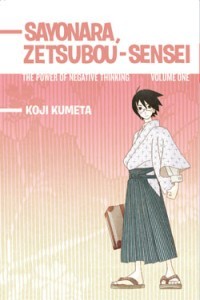
Vol. 1
(by Koji Kumeta, Del Rey, $10.99)
FROM THE BACK COVER:
"Nozomu Itoshiki is depressed. Very depressed. He's certifiably suicidal, but he's also the beloved schoolteacher of a class of unique students, each charming in her own way: The stalker. The shut-in. The obsessive-compulsive. The girl who comes to class everyday with strange bruises. And Kafuka, the most optimistic girl in the world, who knows that every cloud has a silver lining. For all of them, it's a special time, when the right teacher can have a lasting positive effect on their lives. But is that teacher Itoshiki, a.k.a. Zetsubou-sensei, who just wants to find the perfect place to die?"
EVIDENCE FOR:
Some people say that Zetsubou-sensei cannot be appreciated without an encyclopedic knowledge of Japanese culture. Liars! The series' style of observational humor is as universal as they come, reflecting on the foibles of modern life that anyone can relate to. The secret, of course, is to take perfectly ordinary things and exaggerate them to the point of absurdity—which is easily done with this cast of nutty, personality-deficient characters, like the girl who's so shy she only communicates in verbally abusive text messages, or the boyfriend-obsessed stalker whose erratic behavior causes other people to stalk her, or the obligatory pantyshot girl (truly, the only way to get any mileage out of that cliché anymore is to make a complete mockery of it). Standing in the eye of the storm is Zetsubou-sensei himself, providing hilarious commentary on the things we often overlook in our daily lives. Like pointing out how a "career goals" exercise might as well be an exercise in things you'll never accomplish. Or the trouble with students who've grown up abroad. The sparse, simple artwork gives room for the humor to stand out, which is all the better, because despair has never been so outright funny.
EVIDENCE AGAINST:
Well, let's start with that sparse, simple artwork, why don't we? Koji Kumeta may be forgiven for sacrificing the layouts so that he can get all the dialogue in. But what is unforgivable is drawing so many short-haired girls that 80% of the students are indistinguishable from each other. Fortunately for us, most of the story still centers on the other 20%, but it's a dangerous state of affairs when the only things separating Kafuka from Everybody Else are her hair ties. Also falling in the category of artistic deficiency is all the background humor involving signs, quotes and other random utterances. Sure, you can check the well-equipped glossary to help you figure that stuff out, but some of those visual gags are so small that it loses the point of being funny and ends up like some kind of Where's Waldo game. The low page count—just 150 pages of actual content—also feels a tad unsatisfying, and they really could have squeezed one more chapter in there...
FINAL VERDICT:
The visual style may provide some reading challenges, but the humor flows effortlessly. This is the kind of smart, incisive comedy that earns an A.

MAGIKANO

Vol. 1
(by Takeaki Momose, Kodansha, ¥514)
FROM THE ENCYCLOPEDIA:
"Ayumi Mamiya is a witch cursed to lose her powers, but there is one boy who can break the spell and save her. Haruo Yoshikawa thinks he is a normal boy, but unknown to him, his three sisters are witches who use their magical powers to keep him protected and ignorant about the existence of magic. Now Ayumi must wake up Haruo's latent powers to save herself ... but his sisters will have none of that."
EVIDENCE FOR:
People these days know exactly what to expect from a harem series. So it comes as a pleasant surprise when Magikano dares to subvert those expectations: most of the girls in Haruo's life are his sisters, which pretty much erases their romantic potential, and more importantly, the presence of magic adds a whole lot more action to an otherwise sedentary genre. Through four moderately long chapters of hot-girl hijinks, the series is at its best when engaged in mischievous, high-level sorcery. Whether it's Haruo suddenly seeing all females in swimsuits and underwear, or Ayumi and the sisters breaking into Haruo's dreams, scenes like these really open the doors for visual flourishes and physical impossibilities that one would never see in a "normal" harem series. But amidst all the explosive spellcasting, there are other certain criteria that must be met—but anyone who was worried that the fanservice might end up pushed aside need not worry. If anything, the magic provides even more opportunities, from the enchantment on Haruo's vision to dramatic skirt-lifting breezes to an entire chapter set at a swimming pool. Now that's magically delicious.
EVIDENCE AGAINST:
If people know what to expect from a harem series, then why would they even bother with this one in the first place? The entire first chapter should be enough to chase off readers: ordinary wimpy guy goes to school, random cute girl transfers into his class, and then of course she must move in with him due to circumstances from the magical world. In fact, the fun magic stuff doesn't even start until about a third of the way through the book—which means 60 pages of suffering just to get there. Even the attempt to establish a background story (something about Ayumi's family rejecting her due to a curse) is just an excuse to make her want to get into Haruo's pants. As for the fanservice, which ought to be the most solid aspect of a work like this, quantity fails to make up for quality: the girls' proportions look oddly short a lot of the time, their provocative poses turn out to be fairly predictable (and most likely photo-referenced), and the numerous Ayumi pantyshots are really, really forced. The babe factor may be magically enhanced, but that doesn't necessarily make it better.
FINAL VERDICT:
Pretty decent as a magical action-comedy series ... but pretty lame as a guy-meets-way-too-many-girls series, with questionable art quality to boot.

Ah, disagreements! Chris Freeman thinks the latest Hayate the Combat Butler is better than I gave it credit for. So here's his review below.
And because the comedy genre is so like that, it'd make a great suggested topic! Send in your reviews for The one comedy series that you just don't get. Does Cromartie fail to strike your funny bone? Do you think Azumanga Daioh is a big waste of time? Let the world know!
HAYATE THE COMBAT BUTLER

Vol. 10
(by Kenjiro Hata, Viz Media, $9.99)
Hayate the Combat Butler is rightly described on the back of volume by Viz Media as a "Screwball Action-Comedy at your service" and I personally don't think the series could be described any better.
Volume 10 was recently reviewed in this column with a C-. I would personally disagree; Hayate the Combat Butler has, since I started reading this (around the release of Volume 3), been my personal favourite.
Over the course of Volumes 8 and 9 we have seen the growing relationship between Hayate and probably the best character in the series, Hinagiku. So to better understand the story at the beginning of volume 10 you will have to read the two previous volumes.* Volume 10 brings this storyline to its conclusion, with Hinagiku's unresolved issues with her past and her feelings towards Hayate. This volume also brings Nagi back into the picture as she has been rather lacking over the previous storyline.
This series has many arguing over its comedy being rather hit and miss—while Viz Media's Yakitate!! Japan might have a better hit rate within the general vote, I can't help laughing my head off more to this manga. The jokes are always absurd and that's the beauty of this series; if the manga tried to be more serious with its jokes it would fail greatly and lose all appeal. The wacky over-the-top style makes this a great escape from reality. The series also has a great range of manga characters that will appeal to fans of all kinds, from Tsundere, Moe, Maids and even the occasional boys-love joke (although the latter is featured more in Volume 9 than 10).
Over the course of this volume the series looks to be going more into the realms of a typical harem type manga, but thankfully it's more then a one-trick pony like Love Hina. Fans looking for lighthearted-themed manga which always deal with the completely absurd will find no greater pleasure than this series. It is still ongoing (at 18 compiled volumes in Japan so far) with an anime series on its way soon (and a second season to start in Japan), so Hayate will be around for a long time to come.
*Carlo's note: I did read Vols. 8-9. Still not a big fan of the Hayate/Hinagiku pairing. That girl just doesn't do it for me...
Is there a hidden gem of manga you'd like to reveal to the world? Is there a piece of garbage that deserves to be bashed in public? Or is there a title that didn't get a fair grade here, and you want to set the record straight?
Now's YOUR chance to be the reviewer! Write a review of about 300-400 words (a little more or less is fine) and include:
- Your name
- Title of manga (and volume no., if applicable)
- Author/Artist
- Publisher
- Briefly describe the story, then explain why this manga is great, terrible, or in between. Be objective, but also be entertaining.
Then send it in to rtoreaders (at) gmail (dot) com. One review will be selected out of all the submissions and will be published in the next column. All types of manga and manga-inspired comickry are accepted, from past and present, from Japan and beyond—what matters is that it's the Reader's Choice! NOTE: Submissions may be edited for formatting and grammar.
discuss this in the forum (23 posts) |